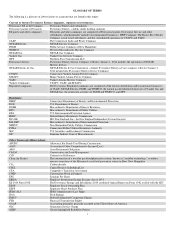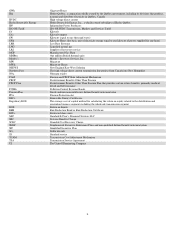Eversource 2015 Annual Report Download - page 20
Download and view the complete annual report
Please find page 20 of the 2015 Eversource annual report below. You can navigate through the pages in the report by either clicking on the pages listed below, or by using the keyword search tool below to find specific information within the annual report.8
• A system benefits charge (SBC), which funds energy efficiency programs for all customers as well as assistance programs for residential
customers within certain income guidelines.
• An electricity consumption tax, which is a state mandated tax on electric energy consumption.
The energy charge and SCRC rates change semi-annually and are reconciled annually and differences between actual costs incurred versus current
rates are either refunded or recovered in subsequent rates charged to customers.
PSNH distribution rates were set in a 2010 NHPUC rate case settlement, which expired on June 30, 2015. In the 2015 PSNH Settlement Agreement,
the Company agreed that its present distribution rates will stay in effect until at least July 1, 2017. However, certain aspects of the 2010 rate case
settlement will continue, including funding for reliability enhancement program activities, adjustment of distribution rates for certain exogenous
events that in the aggregate exceed $1 million, and major storm reserve funding.
Generation Divestiture
In 2013, the NHPUC opened a docket to investigate market conditions affecting PSNH’s default energy service rate, how PSNH will maintain just
and reasonable rates in light of those conditions, and any impact of PSNH’s generation ownership on the New Hampshire competitive electric
market. In April 2014, the NHPUC staff issued a “Preliminary Status Report Addressing the Economic Interest of PSNH’s Retail Customers as it
Relates to the Potential Divestiture of PSNH’s Generating Plants,” which included a consultant’s analysis of the fair market value of PSNH
generating assets and long-term power purchase contracts. The consultant’s analysis estimated the fair market value of PSNH’s generation assets to
be $225 million as of December 31, 2013 and compared that amount to a stated net book value of $660 million, implying potential “stranded costs”
of approximately $435 million. An abbreviated draft update by the consultant dated August 17, 2015, increased the estimated fair market value of
PSNH’s generation assets to $235 million.
In 2014, the Legislature enacted changes to the laws governing divestiture of PSNH’s generation assets, effective September 30, 2014. The new law
required the NHPUC to initiate a proceeding to determine whether all or some of PSNH’s generation assets should be divested. The law gives the
NHPUC express authority to order the divestiture of all or some of PSNH’s generation assets if the NHPUC finds it is in the economic interest of
customers to do so. The law also clarified the definition of “stranded costs” to include costs approved for recovery by the NHPUC in connection
with the divestiture or retirement of PSNH’s generation assets.
On June 10, 2015, Eversource and PSNH entered into the 2015 Public Service Company of New Hampshire Restructuring and Rate Stabilization
Agreement (the Agreement) with the New Hampshire Office of Energy and Planning, certain members of the NHPUC staff, the Office of Consumer
Advocate, two state senators, and several other parties. The Agreement was filed with the NHPUC on the same day. Under the terms of the
Agreement, PSNH has agreed to divest its generation assets upon NHPUC approval. The Agreement is designed to provide a resolution of issues
pertaining to PSNH’s generation assets in pending regulatory proceedings before the NHPUC. The Agreement provided for the Clean Air Project
prudence proceeding to be resolved and all remaining Clean Air Project costs to be included in rates effective January 1, 2016. As part of the
Agreement, PSNH has agreed to forego recovery of $25 million of the deferred equity return related to the Clean Air Project. In addition, PSNH will
not seek a general distribution rate increase effective before July 1, 2017 and will contribute $5 million to create a clean energy fund, which will not
be recoverable from its customers.
In 2015, the Legislature enacted changes to law to allow the use of securitization financing to recover any stranded costs resulting from the
divestiture of PSNH’s generating assets. If the Agreement is approved, following divestiture of PSNH’s generating assets, bonds will be issued to
recover resulting stranded costs.
On January 26, 2016, Advisory Staff of the NHPUC and the parties to the Agreement filed a stipulation with the NHPUC agreeing that near-term
divestiture of PSNH’s generation was in the public interest and that the Agreement should be approved. Implementation of the Agreement is subject
to NHPUC approval, which is expected in early 2016.
Sources and Availability of Electric Power Supply
During 2015, approximately 54 percent of PSNH’s load was met through its own generation, long-term power supply provided pursuant to orders of
the NHPUC, and contracts with competitive energy suppliers. The remaining 46 percent of PSNH’s load was met by short-term (less than one year)
purchases and spot purchases in the competitive New England wholesale power market. PSNH expects to meet its load requirements in 2016 in a
similar manner. Included in the 54 percent above are PSNH’s obligations to purchase power from approximately two dozen IPPs, the output of
which it either uses to serve its customer load or sells into the ISO-NE market.
Merrimack and Schiller Stations have recently operated at lower than typical capacity factors due to moderate regional temperatures. The Hydro
stations have been operating at high capacity factors. PSNH’s Energy Service Rate has been set at 9.99 cents per kWh effective January 1, 2016,
which includes 1.27 cents per kWh reflecting full recovery of costs related to the Clean Air Project.
ELECTRIC TRANSMISSION SEGMENT
General
Each of CL&P, NSTAR Electric, PSNH and WMECO owns and maintains transmission facilities that are part of an interstate power transmission
grid over which electricity is transmitted throughout New England. Each of CL&P, NSTAR Electric, PSNH and WMECO, and most other New
England utilities, are parties to a series of agreements that provide for coordinated planning and operation of the region’s transmission facilities and
























